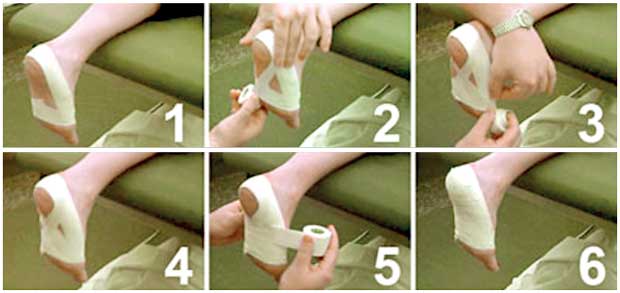Reply To:
Name - Reply Comment

 Do you experience severe heel pain as soon as you get out of bed in the morning? Does it feel better to stay in bed the whole day rather than exercise or go jogging?
Do you experience severe heel pain as soon as you get out of bed in the morning? Does it feel better to stay in bed the whole day rather than exercise or go jogging?
One of the commonest limb conditions involving the heel, known as ‘Plantar Fasciitis’, has a high incidence among individuals who use their lower limbs with more energy and more frequency.
What is plantar fasciitis?
It is a type of injury commonly seen in athletes and soldiers who walk or run for many hours on grounds with hard surfaces, such as rough gravel. Furthermore, this can also affect overweight (obese) individuals and those who wear uncomfortable or poorly-fitting shoes. Middle-aged women are also at high risk and those with tight calf muscles or Achilles tendons which limit the flexing capacity of the ankles are also vulnerable.
According to the latest research, individuals born with hereditary flat feet or high arches may also have plantar fasciitis, due to their feet constantly touching the ground and resulting in an undue strain on the heel.
As far as the pathophysiology behind plantar fasciitis is concerned, the thick band of tissue-ligament known as plantar fascia which runs across the base of your foot connecting the heel bones to the toes, thus creating the arch of the foot, may become inflamed. This gives rise to warmth, redness, swelling, stiffness, pain and relative immobility.
In healthy individuals, this ligament is able to bear a massive degree of pressure and thereby act as a shock absorber, being resistant to daily wear and tear. However, if the level of tension exceeds the limit or if there are some underlying medical conditions which result in the weakening of the ligament, this could give rise to inflammation even after minor trauma or strain.
Are you a victim?
Symptoms of this condition varies from person to person, depending on the severity, anatomical location of the impaired structures and their relationship with nearby tissues, ligaments and nerves in the area.
In fact, most affected individuals will initially have a sharp stabbing pain, often referred to as a ‘stone bruise’, which arises when the feet touch the floor while walking or after getting out of bed. This pain characteristically reduces with the elevation of the limb. This might worsen following prolonged hours of standing, sitting or climbing stairs and running.
Moreover, some people may also describe this pain as a dull ache or discomfort which often arises from the mid foot area, whereas some will have a burning sensation in the sole, which is felt to be radiating away from the heel towards the ankle.
However, if your foot pain worsens towards the end of the day, it is highly recommended to consider possible causes such as arthritis and Tarsal tunnel syndrome, which should be diagnosed with imaging techniques like X ray of the foot and following medical guidance.
If you have these signs and symptoms, seek immediate medical advice. Early intervention will play a major role in helping you avoid possible lifelong disabilities caused by Plantar Fasciitis.
What are the treatment options available?
As far as the major treatment approaches for this condition are concerned, finding out the responsible etiology is important to prevent further episodes. A proper history on the initiation, history of trauma, symptoms, along with a complete physical examination to determine the level of disability and affected areas are necessary to provide a quick recovery. According to most medical practitioners, plantar fasciitis is a self-limiting condition which will often resolve spontaneously with appropriate pain relief and bed rest-immobilization. If the primary management options such as anti-inflammatory drugs (NSAIDs), rest, modification of activity, corticosteroids, botulinum toxin type A, splinting, shoe modifications and orthoses do not work, 10% of patients may require surgical intervention.
Plantar fasciitis taping
‘Plantar fasciitis taping’ is a very common technique used to treat patients with this condition and is known to be effective in relieving the stress on the plantar fascia ligament. It is also known to relieve pain and inflammation associated with plantar fasciitis, heel spurs and other inflammatory conditions resulting in foot pain.
A method widely used among athletes to reduce heel strain by lowering the stretchable ability of the plantar fascia ligament is wrapping an athletic or kinesiology tape tightly around the foot. This will eventually reduce the incidence of wear and tear injuries.
In order to maximize the effectiveness of this method, individuals currently suffering from plantar fasciitis can be treated with a combination of taping and other options like pain relief and anti-inflammatory drugs for a quick recovery. Taping individually will help to prevent future occurrences, as an early preventive measure.
How can you apply the tape?
The tape is usually applied in the morning to reduce the strain throughout the day or just prior to exercise, in order to keep the fascia from moving too much during physical activity.
Keep in mind not to leave your foot taped throughout the day and night because this will limit blood flow and prevent normal metabolic activities. It is also important to paste the tape properly, so it is advisable to clean the foot with a non-moisturising soap and dry it prior to taping.
Step-by-step procedure
1. Begin with the tape wrapped around the ball of the foot (metatarsal) area.
2. Then, wrap another piece of tape around the heel, attaching it to the tape around the ball of the foot as shown in the picture.
3. Place a strip of tape around the metatarsal region and cross the mid-foot diagonally before wrapping it around the heel and crossing the mid-foot again.
4. This will be visible as an X shape across the mid-foot and will be responsible for providing support to the plantar fascia.
5. The taping should be done about three times to ensure a strong support.
6. To wrap up the process, apply the tape horizontally across the foot to cover the previous strips.
7. The bottom (plantar) surface of the foot should be seen almost entirely covered from the metatarsal region to the heel which will add the support required to allow the fascia ligament to rest with limited movements.
The success rate for complete recovery following this treatment will depend on the pathology of the condition, habits of the individual and lifestyle. high-risk groups, while providing an effective pain relief for those already.